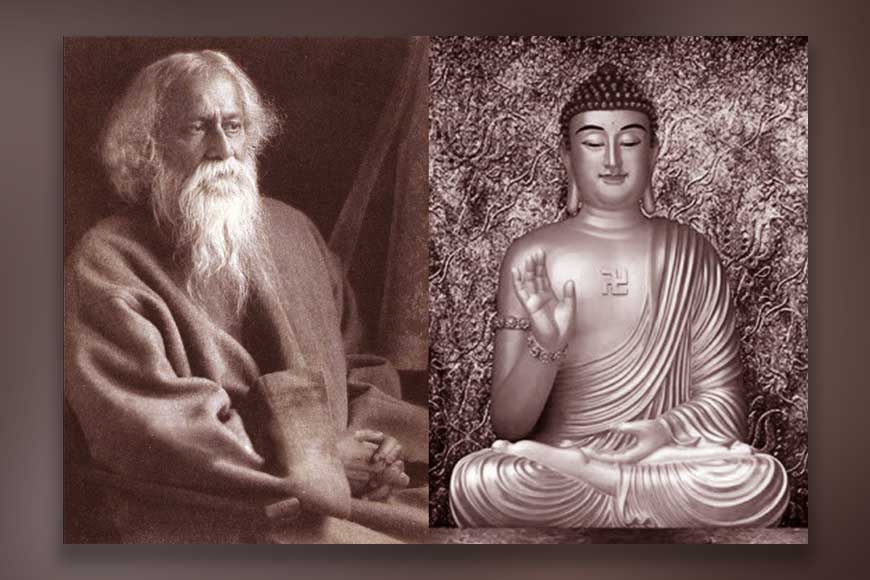

Some songs mimicked a given raga's melody and rhythm faithfully others newly blended elements of different ragas. They emulated the tonal colour of classical ragas to varying extents. Influenced by the thumri style of Hindustani music, they ran the entire gamut of human emotion, ranging from his early dirge-like Brahmo devotional hymns to quasi-erotic compositions. His songs are known as rabindrasangit ("Tagore Song"), which merges fluidly into his literature, most of which-poems or parts of novels, stories, or plays alike-were lyricised. The leading proponent of Bengali music is Rabindranath Tagore (known in Bengali as Robi Thakur and Gurudeb, the latter meaning "Respected Teacher" (in the Bengal of that time, the suffix 'deb' was an honorific, ascribed to people who enjoyed immense respect, but this title was primarily used by his students at Santiniketan, though many others did use the address/ ) Tagore was a prolific composer with around 2,230 songs to his credit. Notable in this devotional poetry is an earthiness that does not distinguish between love in its carnal and devotional forms some see connections between this and Tantra, which originated sometime in the middle of the first millennium CE.įorms Bishnupur Gharana Another writer of the time was Vidyapati. Much of the early canon is devotional, as in the Hindu devotional songs of Ramprasad Sen a bhakta who captures the Bengali ethos in his poetic, rustic, and ecstatic vision of the Hindu goddess of time and destruction in her motherly incarnation, Ma Kali. The Middle Ages saw a mixture of Hindu and Islamic trends when the musical tradition was formalized under the patronage of Sultan and Nawabs and the powerful landlords baro bhuiyans. Partha Barua is one of the pioneers of Bangladeshi rock.The earliest music in Bengal was influenced by Sanskrit chants, and evolved under the influence of Vaishnav poetry such as the 13th-century Gitagovindam by Jayadeva, whose work continues to be sung in many eastern Hindu temples. Festivals īuddha's Birthday is a public holiday in Bangladesh.īengali Buddhists also celebrate the festival of Madhu Purnima.īipradash Barua is a Bangladeshi author and novelist. The artistic tradition continued under the Sena rulers, and thus the term "Pala-Sena" is sometimes used.

It influenced art outside of India as well. The art for their period is termed Pala art. Culture Art īuddhist art flourished under the Pala rulers. Buddhists constitute 3.41% or 125,182 of the population in Tripura.

According to 2011 India census, Bengali Buddhists constitute 0.3% or 282,898 of the population in West Bengal. The eastern Indian state capitals of Agartala and Kolkata also have significant Bengali Buddhist communities.īengali Buddhists constitute 0.59% or 10,00,000of the population in Bangladesh. Many members of community reside in Dhaka, Cox's Bazar and Comilla. They usually enjoy a high literacy rate and are found in the Bangladeshi middle class, particularly in the port city of Chittagong. Ī Buddhist temple on Maheshkhali Island, Chittagongīangladesh is home to the predominant section of the Bengali Buddhist community. According to Muhammad Ghulam Rasul, Brahmin persecution played a key role in the decline of Buddhism in India followed by later Muslim conquest. They reigned for four centuries until being replaced by the resurgent Hindu Sena dynasty. The empire reached its peak under Dharmapala and Devapala. The Palas enjoyed strong relations with the Abbasid Caliphate, the Tibetan Empire and the Srivijaya Empire. They patronized the creation of many outstanding temples, monasteries and works of art. The Palas promoted Mahayana and Tantric Buddhism. Founded by the election of Buddhist chieftain Gopala circa 750 CE, the empire grew into one of the largest imperial powers in classical Asia. The Bengali Buddhist Pala Empire arose during the 8th century. Successive Buddhist powers tussled for dominance with Hindu and Jain kings in the Indian subcontinent. Mauryan rule was succeeded by the Buddhist Samatata maritime kingdom in Bengal. Ashoka played an important role in propagating Buddhism in his own empire and the wider ancient world. The Mauryan Empire led by Ashoka extended its suzerainty to the region in the 2nd century BCE. Buddhist artifacts have been excavated throughout the region, particularly in Wari-Bateshwar, Chandraketugarh, Paharpur, Mahasthangarh and Mainamati. Somapura Mahavihara from the Pala dynasty, a UNESCO World Heritage SiteĪncient Bengal was a center of Buddhist learning and art.


 0 kommentar(er)
0 kommentar(er)
